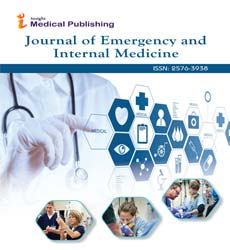ISSN : 2576-3938
Journal of Emergency and Internal Medicine
A Brief Note on Nonsteroidal Anti-Inflammatory Drug
Rosen Berg*
Department of Surgery, University of Munchen, Munchen, Germany
- *Corresponding Author:
- Rosen Berg
Department of Surgery, University of Munchen, Munchen, Germany
E-mail: Rosenberg159@edu.com
Received date: November 5, 2021; Accepted date: November 19, 2021; Published date: November 26, 2021
Citation: Berg R (2021) A Brief Note on Nonsteroidal Anti-In lammatory Drug. J Emerg Intern Med Vol.5 No.3: e004.
Description
The characteristic of a medication or therapy that lowers inflammation or swelling is known as anti-inflammatory. About half of analgesics are anti-inflammatory medications, sometimes known as anti-inflammatories. In contrast to opioids, which impact the central nervous system and inhibit pain communication to the brain, these medicines treat pain by lowering inflammation.
Nonsteroidal Anti-Inflammatory Medicines (NSAIDs) work by inhibiting the eynmz e cyclooxygenase (COX). COX enzyme produces prostaglandins on its own, causing inflammation. Overall, NSAIDs inhibit prostaglandins from being formed, so lowering or eliminating inflammation and discomfort.
Aspirin, ibuprofen, and naproxen are some examples of NSAIDs. Even though they theoretically have the same method of action, the newer specialised COX-inhibitors are not classed alongside the classic NSAIDs.
Analgesics, on the other hand, are frequently connected with anti-inflammatory medications yet have no anti-inflammatory properties. Paracetamol (also known as acetaminophen or Tylenol) is one example. Contrary to NSAIDs, which reduce pain and inflammation by inhibiting COX enzymes, paracetamol has been shown to block the reuptake of endocannabinoids, which only reduces pain, likely explaining why it has little effect on in lammation; paracetamol is sometimes combined with an NSAID (instead of an opioid) In clinical practise, NSAIDs are used to provide pain relief while maintaining the injury or diseasemoderating effects of NSAID-induced inflammation.
Most common Nonsteroidal anti-inflammatory medicines:
• Aspirin
• Ibuprofen
• Naproxen sodium
• Nonsteroidal Anti-In lammatory drugs (NSAIDs) are used to treat
• Rheumatoid Arthritis (RA), osteoarthritis, and tendonitis all cause pain
• Muscle pain
• Backaches
• Pain in the teeth
• Gout is a painful condition
• Bursitis
• Menstrual cramps are a common occurrence
NSAIDs work by inhibiting the generation of specific substances in the body that cause in lammation. Anti-In lammatory drugs (NSAIDs) are effective in treating pain caused by gradual tissue deterioration, such as arthritic discomfort. NSAIDs are also effective in the treatment of back pain, menstrual cramps, and headaches.
NSAIDs act in the same way as corticosteroids (commonly known as steroids) do, but without the negative side effects. Steroids are synthetic versions of cortisone, a naturally occurring hormone. NSAIDs, like cortisone, help to relieve pain and in lammation caused by joint and muscle disorders and accidents.
Long-term usage of NSAIDs can produce gastric erosions, which can lead to stomach ulcers and, in the worst-case scenario, fatal bleeding. For individuals aged 16–45, the risk of mortality from GI bleeding due by the use of NSAIDs is 1 in 12,000. Over the age of 75, the risk increases about twenty four. Other risks of NSAIDs include aggravating asthma and harming the kidneys. Prescription and over-the-counter NSAIDs, in addition to aspirin, raise the risk of heart attack and stroke.
Antileukotrines are anti-in lammatory compounds that act as inhibitors of leukotriene-related enzymes (arachidonate 5- lipoxygenase) or antagonists of leukotriene receptors (cysteinyl leukotriene receptors), hence inhibiting the activity of these in lammatory mediators. Despite the fact that they are not used for analgesic purposes, they are commonly employed in the treatment of disorders involving lung in lammation (e.g., asthma, COPD) and sinus in lammation in allergic rhinitis. They're also being studied for usage in brain-in lammationrelated disorders and traumas (such as Parkinson's disease). Anti-in lammatory medication studies for those who already have Alzheimer's disease have o ten had no effect on slowing or reversing the illness.
Open Access Journals
- Aquaculture & Veterinary Science
- Chemistry & Chemical Sciences
- Clinical Sciences
- Engineering
- General Science
- Genetics & Molecular Biology
- Health Care & Nursing
- Immunology & Microbiology
- Materials Science
- Mathematics & Physics
- Medical Sciences
- Neurology & Psychiatry
- Oncology & Cancer Science
- Pharmaceutical Sciences
